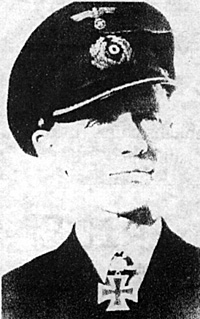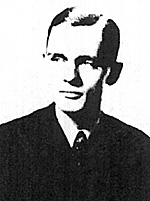
This is the first time this interview will be reported in our KTB Magazine. He was known as the ‘Drumbeater’ because he was the first U-Boat on station in 1942 for Operation ‘Drumbeat’, he sank the first ship during that operation in American waters, and he is today, the only surviving Skipper of Operation ‘Drumbeat’.
We did this interview with Captain HARDEGEN in 1994 and if you wish to view it in its uncut entirety, you may order: Tape H-52, 1994 Interview, Captain Hardegen at $30 (plus $5 shipping) from Sharkhunters
SHARKHUNTERS:
Captain Hardegen, you wanted to be an aviator, but somehow you came to be in the submarine force. How did that happen?
Captain HARDEGEN:
I entered the Navy and then in 1935, I was ordered to go to the Naval Air Force and after the Poland War, I was ordered to go to the submarines.
Hardegan with Knights Cross and Oak Leaf.
SHARKHUNTERS:
So you got your orders and as a soldier you went, right?
Captain HARDEGEN:
Yes, of course. I had to obey.
SHARKHUNTERS:
Can you tell us about your first mission? What was that like? When you got your orders and you first came to the United States, can you tell us how you found it? What about the conditions and the country itself?
Captain HARDEGEN:
When I came to the United States, the first time, and I found New York and I was off the coast of Long Island and I saw all the lights and all the motorcars and so on, and I thought it would be a big surprise for the United States, but I didn’t know that the English had already cracked our naval cipher and Admiral Ernest King, he’s a man I thank to be alive today because he was such a bad admiral that he didn’t do anything and it wasn’t a surprise. The English gave him everyday, my position and he knew where I came, but he did nothing. He had twenty-five destroyers in the port, and he left them in the port and all the lights were on the lightships. No dimming, no blackout and so on. It’s fascinating.
EDITOR NOTE – It had been widely reported that Captain Hardegen could see the dancers on the rooftop gardens of the Waldorf Astoria but as he points out, he was never that close to the city.
SHARKHUNTERS:
So you were able to use the same navigational lights and markers the American shipping was using?
Captain HARDEGEN:
Yes, yes. But you see, I didn’t see the skyscrapers of New York. Sometimes in the American press, they said that I saw the people dancing on the roof of the Waldorf Astoria. That is nonsense. I didn’t pass the Narrows and so I saw only the glow of the lights of New York. I saw the coast of Long Island and the lightship and those things.
SHARKHUNTERS:
When you were coming down the coast of New York, could you see the amusement park at Coney Island through your binoculars?
Captain HARDEGEN:
I saw without the binoculars, with my eyes – I was so near to the coast, I could see all. With my eyes; I did not use the binoculars.

SHARKHUNTERS:
This must have been very surprising for you. After all, here you are – the battle with the British had become very difficult and now you are on the coast of the United States. With your own eyes, you can see the cars driving; you can see the amusement park – what were you thinking at that time?
Captain HARDEGEN:
Well, that was a long time ago……..but I waited for ships coming out of the harbor of New York. When the first ship, the tanker NORNESS came,. I followed her until the water was deep enough, and so I torpedoed her.
EDITOR NOTE – Captain Hardegen refers to the Panamanian Flagged 9,577 ton motor tanker NORNESS. The fact that she flew the Panamanian Flag could indicate that this was a flag of convenience after the Neutrality Act forbade any American ships from carrying war supplies…companies were known to re-flag their ships to circumvent this new law.
SHARKHUNTERS:
Then you moved further south, off the coast of Virginia and North Carolina, in close to shore, the water is fairly shallow – can you tell us about the difficulties of operating a submarine in shallow water?
Captain HARDEGEN:
It was difficult because I was not able to dive, but near the coast, there were ships. If I knew before that Admiral King had known that I was there, I never would be so near to the shore. I would be beyond the 200 meter line – but there were no ships there.
SHARKHUNTERS:
We have heard it described that the waters on the American east coast contain a plankton that would be phosphorescent when a ship would move through – in effect, the waters would glow when a ship went through. Could you see that on your voyage?
Captain HARDEGEN:
I don’t remember it. Maybe sometimes, but nothing special.
SHARKHUNTERS:
U-123 is renowned for sinking a large number of ships with her deck gun. Please tell us what it is like to engage a ship with the deck gun. For instance, what were the problems encountered by the gun crew?
Captain HARDEGEN:
I followed the ships because I knew they had only the lookout in front, and none astern and then my gun crew was on deck and then in the last moment, I went to the portside for instance, and then I ordered the gun crew to open fire. We sank five ships only by gun.
SHARKHUNTERS:
Was there any rivalry between the men who worked in the torpedo rooms versus the men who worked the deck gun?
Captain HARDEGEN:
No, because very often they were the same people. The gun crew is not only special for the gun, they also do other things. I have not the soldiers only for the guns.
SHARKHUNTERS:
Off the coast of Florida, (2nd patrol in American waters) you sank a tanker very close to shore and we understand that you began to shell the tanker with your deck gun and then you saw people coming out on the shore and you were afraid that one of your shells would miss the ship and hit the shore. Can you tell us about this action?
Captain HARDEGEN:
It was the GULF AMERICA off St. Augustine. I torpedoed her & then I wanted to shell her – I didn’t start shelling her because the ship was between the coast and me, and so went around the ship and shelled her from the shore out to sea so that no shell can hit the people ashore. It was very dangerous for me because my ship was silhouetted against the burning tanker and I didn’t know if there were guns ashore. I saw a lot of motorcars and I saw the hotels. A few years ago, I was in St. Augustine and I said to the Lord Mayor that he must invite me for some weeks every year because in 1942 it was a big spectacle for his town, and all the people came to look at the burning tanker. They were drinking, I guess beer, and eating, and so he made a good business and now the sunken ship is full of barnacles and all the divers come and look at the fish on the sunken tanker GULF AMERICA and so he has another big business for his town. But we were laughing about this idea.
SHARKHUNTERS:
Probably the biggest event for that town.
Captain HARDEGEN:
Yes.
The evening of his sinking the GULF AMERICA was nearly the last for Captain Hardegen and the crew of U-123, as an American destroyer found them. We’ll read about that in KTB #168 next month. Don’t miss this first-person memory of the war at sea.
More Hardegan:
Korvettenkapitan Reinhard Hardegan Part 1
Korvettenkapitan Reinhard Hardegan Part 2
Korvettenkapitan Reinhard Hardegan Part 3
Back to KTB # 167 Table of Contents
Back to KTB List of Issues
Back to MagWeb Master Magazine List
© Copyright 2003 by Harry Cooper, Sharkhunters International, Inc.
This article appears in MagWeb.com (Magazine Web) on the Internet World Wide Web. Other military history articles articles are available at http://www.magweb.com
Join Sharkhunters International, Inc.: PO Box 1539, Hernando, FL 34442, ph: 352-637-2917, fax: 352-637-6289, www.sharkhunters.com
